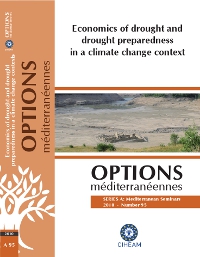| Article précédent | p. 183-189 | Article suivant |
Cost-effectiveness analysis of a water scarcity management plan: Considering long term socioeconomic and climatic changes
This paper presents an economic analysis of a water scarcity management plan developed with local land and water planning agencies in a 5000 km² Mediterranean costal area in Languedoc Roussillon, France. A baseline scenario is first developed for 2020-2040. Using statistical data and a consultation of experts, we formulate consistent assumptions related to future population growth, agricultural land use and production, irrigation performance and type of urban development. Agricultural and urban water demand are predicted and compared with future water resource availability, estimated taking into account climate and hydrological change assumptions. The gap between demand and available resources is estimated at 10 to 50 millions m3 per year, depending on assumptions made. A programme of actions is then developed to reduce this gap, considering demand management actions (e.g. modernisation of irrigation systems, rain water harvesting, water saving technologies, water pricing) and the mobilisation of new water resources (desalination, inter-basin transfer, deep groundwater use). A cost effectiveness analysis is performed to optimise the programme of actions.
Cet article présente une évaluation économique d'un plan de gestion de la rareté de l'eau dans deux bassins versants littoraux en région Languedoc Roussillon, France. Un scénario tendanciel est d'abord développé pour 2020-2040. Il repose sur une série d'hypothèses relatives à l'évolution future de la démographie, de l'aménagement du territoire, de la performance des systèmes irrigués et du type de développement urbain. Les demandes en eau urbaine et agricole sont estimées et comparées aux ressources susceptibles d'être disponibles dans le futur, en intégrant la perspective de changement climatique. Le déficit en eau estimé est compris entre 10 et 50 millions de m3 selon les hypothèses climatiques considérées. Un programme d'actions permettant de résorber ce déficit est ensuite élaboré, en intégrant des actions visant à mobiliser de nouvelles ressources, à moderniser les périmètres irrigués ou à gérer la demande en eau potable. Une analyse coût-efficacité est ensuite mise en oeuvre pour comparer ces mesures et en optimiser la combinaison.
- [ Afficher ]
- [ Télécharger ]
- [ Exporter la citation ]
Vous pouvez télécharger la citation au format :
- [ Imprimer ]
-
Mots-clés
ANALYSE COUT AVANTAGE, CHANGEMENT CLIMATIQUE, EAU DISPONIBLE, FRANCE, GESTION DES EAUX, LANGUEDOC-ROUSSILLON, PROGRAMME D'ACTIONCiter cet article
Rinaudo J.D., Maton L., Caballero Y. Cost-effectiveness analysis of a water scarcity management plan: Considering long term socioeconomic and climatic changes. In : López-Francos A. (comp.), López-Francos A. (collab.). Economics of drought and drought preparedness in a climate change context. Zaragoza : CIHEAM / FAO / ICARDA / GDAR / CEIGRAM / MARM, 2010. p. 183-189. (Options Méditerranéennes : Série A. Séminaires Méditerranéens; n. 95). 2. International Conference on Drought Management, 2010/03/04-06, Istanbul (Turkey). http://om.ciheam.org/om/pdf/a95/00801344.pdf



